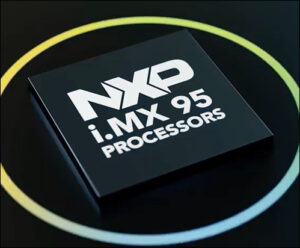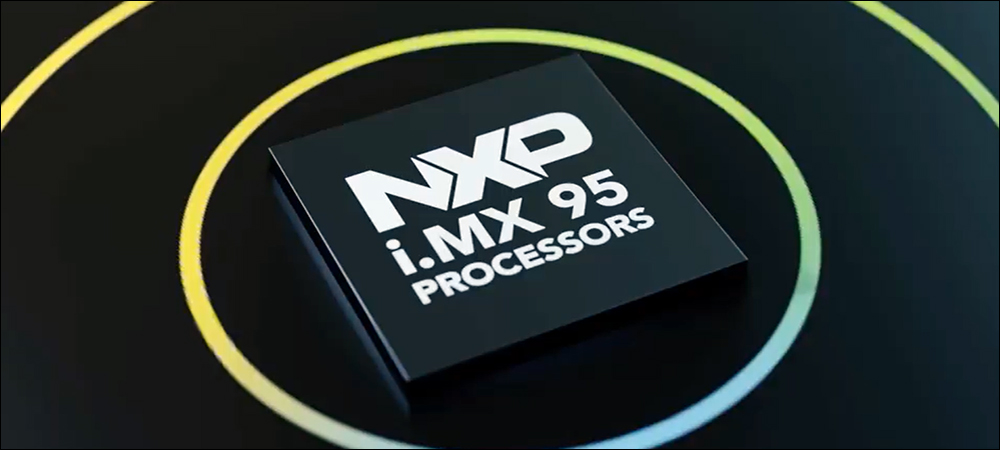- IoT Edge Processing and Connectivity
- Adding Flexibility and Functionality
- Expanding IoT Features for Healthcare
- Smart Shopping Carts for Retail
Although technology systems using NXP Semiconductors‘ new i.MX 95 application processors will not be made commercially available until 2025, several companies will soon be developing new solutions that will expand how the Internet of Things (IoT) and other connected systems are used across numerous markets. NXP announced its new product and is working with businesses that are building everything from connected automotive applications to Industry 4.0 manufacturing sites and smart homes.

NXP’s i.MX 95 application processor
The new processor, according to NXP, will enable IoT rollouts that can integrate greater functionality and perform faster, with more data, than previous processors could. This, the company explains, better enables the processing of sensor information at the edge. The i.MX 9 product family is intended for automotive, industrial and IoT edge-processing applications.
The other member of the i.MX 9 product family, the i.MX 93, was released for edge automotive, industrial and IoT markets in late 2021. However, the i.MX 95 is designed to provide greater performance, with more features and more accelerators, as well as some key new intellectual property, says James Prior, NXP’s product manager. For one thing, he adds, the neural processing unit (NPU) is more powerful in the i.MX 95 than in the i.MX 93, which means it can detect objects or conditions at a faster speed from a number of different sources.
In previous years, NXP released its i.MX 7 and i.MX 8 processor families, intended for general-purpose edge processing and ultra-low-power applications with graphics management. Now, the i.MX 9 series expands on those product lines, starting with the i.MX 93 and i.MX 95. with other versions expected in the future. It’s part of what Prior calls a growing opportunity that semiconductors offer specifically in the intelligent edge.
IoT Edge Processing and Connectivity
With 50 billion IoT-based devices predicted to be in use by 2025, Prior says, there will be a need for more edge-processing functionality to integrate data and ensure greater security. Going forward, he predicts, “You’re going to need to have purpose-built, specifically designed processors that enable efficient secure computing.” When it comes to connectivity via Wi-Fi, 5G, Bluetooth Low Energy (BLE) or ultra-wideband (UWB), for instance, information will be transmittable at higher data rates, which would be useful for applications such as smart-home entertainment devices.
The latest processor, like its i.MX 93 predecessor, offers secure connected edge functionality, leveraging NXP’s elQ Neutron NPU to accelerate artificial intelligence (AI) applications. NXP’s SafeAssure framework comes with compliance to safety standards, such as ASIL-B and SIL2, so that developers can more quickly create solutions that come with necessary platform safety measures.
For the automotive industry, this latest processor is targeting e-cockpit applications, including driver information systems and high-end connectivity domain controllers. The solution can also be used in patient-care platforms for the healthcare industry, to integrate such features as patient monitoring with vital readings, visual and audible alerts, and medical image sensor processing. It enables critical device control as well, Prior says, for monitoring and connectivity for pumps, respirators, in-home monitoring systems and other devices.
Adding IoT Flexibility and Functionality
One example of an IoT-based solution for retail would be smart shopping carts. With the smart carts leveraging the i.MX 95 processor, NXP indicates, multiple displays with touchscreen control could interface and connect to shopping lists and available products at a shopper’s home. Smart homes serve as another application in which the new products could be deployed.

James Prior
For instance, the processor could be used in a gateway device that would provide support for connected security cameras, lighting controls and entertainment systems. Both the i.MX 93 and 95 are built to be flexible so that original equipment manufacturer designers can customize the system according to their present needs, and as those needs expand. “We built them in a scalable way,” Prior says, “so that they you can grow from one platform to the next.”
The automotive industry provides an example of how much flexibility is required. There’s been a transition for car makers, Prior notes, consolidating smaller functions in vehicles to more domain and zonal types of architecture. The i.MX 95 integrates application processing and real-time processing with safety processing to drive multiple displays in a vehicle from a single software-on-chip. “[The system] can be balanced to blend those functions together,” he explains. What that means is users have real-time functional safety operations running at the same time as many other applications.
Such applications, Prior says, could include connected cameras—as many as eight around a car—and low-light and extended-vision capabilities. “That could be very useful for surround-view parking,” he states, “or for occupant monitoring and front and rear cameras.” The processor can also enable an e-cockpit digital environment with fewer physical dials and more generated displays. Only critical information would need to be displayed, while other processing would take place on the chip.
Expanding IoT Features for Healthcare
The new processor’s flexibility is intended for healthcare platforms as well. For example, if a hospital wanted to track infusion pumps, respirators or other assets, it could use a variety of technologies to accomplish this, such as RFID, BLE, UWB or Wi-Fi. The collected data could then be processed by the i.MX 93 or i.MX 95 edge device, enabling users to understand the location and related status of each piece of equipment, including whether it is being used in a patient room or is being washed in the cleaning area.
Beyond that functionality, data such as the device’s operation and maintenance history could be captured and processed at the edge, enabling hospitals to receive an alert or reports—for instance, regarding use history and when repair or inspection might be needed. The data could also be integrated with the device’s base functionality to determine duty cycles or potential changes in operation.
In addition, NXP reports, there is a potential for industrial applications—for example, tracking the conditions and operation of mechanical equipment at a utility or manufacturing site. In this scenario, a variety of sensor-based data could be captured and processed securely at the edge to provide predictive maintenance information, as well as diagnostics and use history, without sending large volumes of data to a server.
Smart Shopping Carts for Retail
One use case being targeted by companies is in stores. Retailers have begun leveraging smart shopping cart solutions to allow shoppers to accomplish self-purchasing. They can use an app on their smartphone to scan products’ barcodes to create their digital shopping cart, placing each item into the physical cart. Such carts can come equipped with digital cameras to identify and confirm the goods being placed within, enabling customers to pay for their groceries without having to wait in line.
According to NXP, the i.MX 95 processor could enable a store to provide faster, more accurate data to such carts. For example, the processor could enable numerous cameras to catch goods at all angles as they are placed in a cart, thereby confirming what each product is via vision processing. This would allow the system to differentiate, for instance, between cabbage and lettuce. The processor can accommodate up to eight directly connected cameras, with networking capabilities for 5G, Wi-Fi, Bluetooth, shortwave or UWB connections.
The battery-powered screen could display a list of products within the cart. It could also capture a shopper’s list or other information from their smart-home devices, such as any items they are running out of in their smart refrigerator. The screen could display wayfinding, using Bluetooth to route shoppers around the store to the products on their shopping list, or to promotional deals.
Other potential applications include systems designed to track camera-based data captured inside sports arenas or stadiums, in order to accomplish everything from simple people counting to crowding detection, while also enabling alerting related to problems like excessively long queues at a vending site. The system is designed for flexibility, since users or developers can now adjust its architecture to use whatever domains they need, and power off those they do not. The i.MX 95 is not yet available in volume, but NXP has opted to announce its features now, to give developers time to prepare.
“What we’ve learned in the last couple of years is that supply chains are a little bit longer, and everybody needs a little bit more time to plan and execute,” Prior states. “So now is the right time to start getting the thought process going so that people can adopt and be ready for these processors when they’re available.” Development is already underway throughout the smart-home, industry, automotive and retail sectors, he reports. “In fact, we’re engaged with lead customers now across all of those markets.”
Key Takeaways:
- NXP’s latest application processor will enable greater flexibility and functionality at the edge for a variety of applications.
- The goal is to foster IoT and other deployments as technology use grows, from automotive to healthcare and public places.


